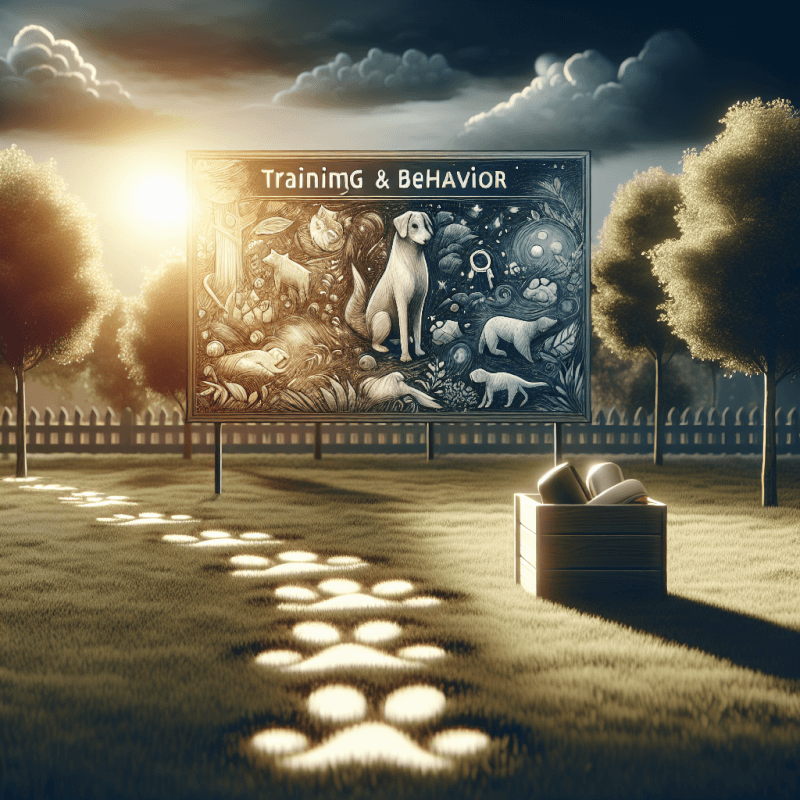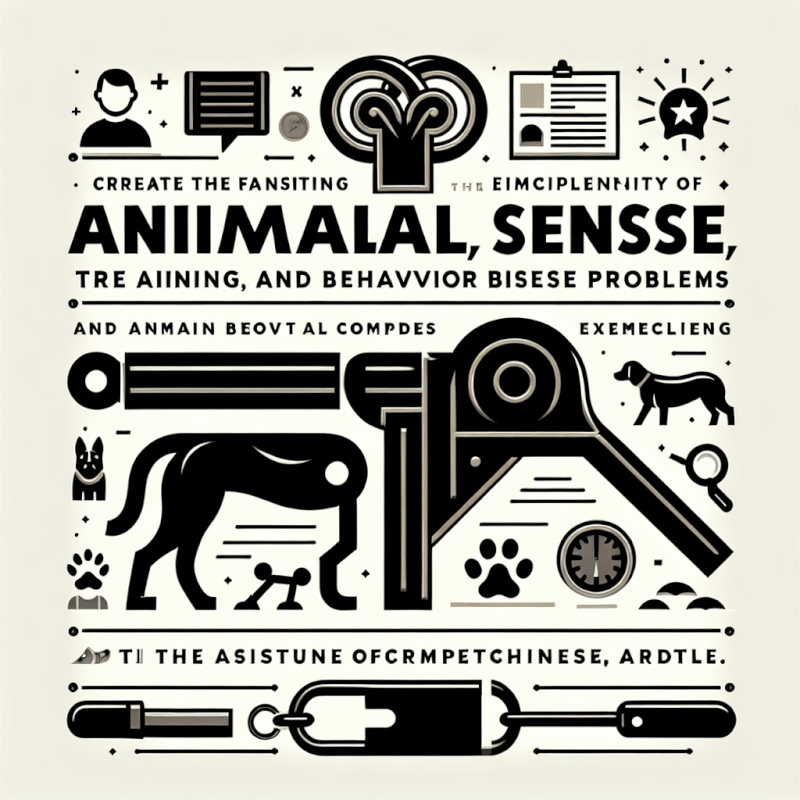In “Animal Sense Basic Training And Behavior Problems,” you will discover how to effectively train your beloved animals and address common behavior issues. Whether you have a misbehaving pup, a stubborn cat, or even a feisty parrot, this article will provide you with valuable insights and tips to ensure a harmonious relationship with your furry or feathered friends. By understanding the foundations of animal sense, you will be equipped with the knowledge to foster a positive training environment and tackle any behavior problems that may arise. So join us on this journey to becoming a skilled and compassionate pet owner!
Understanding Animal Senses
Sensory perception in animals
Animals possess a wide range of sensory abilities that allow them to interpret and navigate their environment. These senses include smell, sight, hearing, touch, and taste. Each species has its own set of sensory organs and capabilities, tailored to their specific needs and way of life. By understanding how animals perceive the world around them, we can better understand their behavior and provide effective training techniques.
Ready for Cat Trivia?
Test your knowledge about cats!

How animals interpret their environment
Animals interpret their environment through a combination of sensory input and learned behaviors. Their senses enable them to detect prey, avoid predators, find mates, and navigate their surroundings. For example, a dog’s keen sense of smell allows them to track scents and identify familiar individuals, while a cat’s exceptional night vision helps them hunt in low-light conditions. By recognizing and appreciating these unique abilities, we can design training methods that align with an animal’s natural instincts and enhance their understanding of their environment.
The role of smell, sight, and hearing in behavior
Smell, sight, and hearing play crucial roles in an animal’s behavior and communication. Smell, often the most powerful sensory cue for many animals, helps them identify potential threats, locate food sources, and mark their territory. Sight allows animals to perceive their surroundings, recognize familiar faces, and interpret body language. Hearing enables animals to communicate with each other, detect danger or prey, and navigate using sound cues. By understanding the significance of these senses, we can tailor our training techniques to effectively communicate with our animal companions.
Basic Training Techniques
Positive reinforcement methods
Positive reinforcement is a widely recognized and effective training technique that rewards desired behaviors. By using treats, praise, or play as rewards, we can motivate animals to repeat behaviors that we want to encourage. This method focuses on rewarding the animal for doing something right rather than punishing them for doing something wrong, creating a positive and enjoyable learning experience.
Using treats and rewards effectively
Treats and rewards are valuable tools in training animals. It is important to choose treats that your animal finds enticing and use them sparingly but consistently. By associating these rewards with desired behaviors, such as sitting on command or walking nicely on a leash, you can reinforce the training and encourage your animal to continue progressing.
Clicker training for animals
Clicker training is a popular technique that uses a small clicking device to mark desired behaviors and signal to the animal that they will receive a reward. The sound of the clicker serves as a clear and distinct signal of success, allowing for immediate reinforcement. This method can be particularly effective for shaping more complex behaviors or teaching tricks.
Establishing clear communication
Clear communication is essential in training animals. Using consistent verbal cues, hand signals, or gestures helps the animal understand what is expected of them. It is important to keep commands simple and use the same cue for a specific behavior. By establishing a common language, you can effectively communicate your expectations to your animal and ensure consistent training outcomes.
Developing trust with your animal
Building a strong bond and trust with your animal is crucial for successful training. Animals are more likely to respond positively to training when they feel safe, secure, and loved. Spending quality time together, providing daily care, and engaging in activities that your animal enjoys can help foster trust and strengthen your relationship. By creating a positive and trusting environment, you can make the training process more enjoyable for both you and your animal.

Addressing Common Behavior Problems
Aggression and territoriality
Aggression and territoriality can be challenging behavior issues to address in animals. These behaviors may be rooted in fear, insecurity, or a desire to protect resources. Understanding the underlying triggers and employing positive reinforcement techniques to redirect the behavior can often help manage and modify aggressive tendencies. Seeking the guidance of a professional animal behaviorist is recommended for cases that require specialized attention.
Separation anxiety
Separation anxiety is a common problem in dogs and can lead to destructive behavior or excessive vocalization when left alone. To address separation anxiety, gradually acclimating the dog to being alone through short periods of separation and providing mental stimulation can help alleviate their anxiety. The use of interactive toys or puzzles can keep them occupied and help distract from their distress. Consultation with a professional trainer or behaviorist can provide additional strategies for managing separation anxiety.
Excessive barking or meowing
Excessive barking or meowing can be a result of various factors, such as boredom, fear, or seeking attention. Identifying the root cause of the behavior is essential to effectively address it. Providing mental and physical stimulation, teaching the “quiet” command, and rewarding calm behavior can help mitigate excessive vocalization. However, if the behavior persists or becomes problematic, consulting with a professional trainer or animal behaviorist is recommended.
Compulsive behaviors
Compulsive behaviors, such as excessive licking, chasing shadows, or tail-chasing, can be indicative of underlying anxiety or stress. Identifying the triggers and implementing a structured routine with consistent training can help alleviate these behaviors. Providing mental and physical stimulation, as well as creating a calm and secure environment, can also assist in managing compulsive tendencies.
Fear and phobias
Fear and phobias can significantly impact an animal’s behavior and quality of life. Gradual desensitization and counterconditioning techniques can help animals overcome their fears by associating positive experiences with previously fearful situations or stimuli. Seeking the assistance of a certified animal behaviorist is recommended for working with animals experiencing severe fear or phobias.
House soiling and litter box issues
House soiling and litter box issues can be a source of frustration for pet owners. These problems can stem from medical issues, improper litter box maintenance, or behavioral factors. Consulting with a veterinarian can help rule out any underlying medical concerns, while establishing a consistent routine and providing appropriate litter box options can help address the behavioral aspects of the problem.
Leash pulling and lunging
Leash pulling and lunging are common challenges faced by dog owners. Teaching loose leash walking techniques, using positive reinforcement to reward desirable behavior, and incorporating distractions and redirection can help address these issues. It is important to approach training with patience and consistency to achieve lasting results.
Destructive chewing or scratching
Destructive chewing or scratching can be a result of boredom, lack of appropriate outlets for natural behavior, or anxiety. Providing suitable toys and chew treats, redirecting the behavior to acceptable alternatives, and creating an enriched environment can help curb destructive tendencies. Consistent training and regular exercise also contribute to maintaining a well-balanced and stimulated animal.
Food guarding and resource aggression
Food guarding and resource aggression can present challenges when it comes to training and behavior modification. Behavior modification techniques, such as desensitization and counterconditioning, can help animals associate positive experiences with the presence of others near their resources. Seeking guidance from a professional trainer or behaviorist experienced in handling aggression issues is vital when addressing these behaviors.
Attention-seeking behaviors
Attention-seeking behaviors, such as barking or pawing, can be disruptive and prevent effective communication with your animal. Consistently providing attention and reinforcement for calm and desirable behaviors, ignoring attention-seeking behaviors, and establishing clear boundaries can help discourage these behaviors. Replacing attention-seeking behaviors with appropriate alternatives, such as engaging in interactive play or providing mental stimulation, can also redirect the animal’s focus.
Specific Challenges for Dogs
Training approaches for different breeds
Different dog breeds have varying temperaments and characteristics, which may require tailored training approaches. Some breeds may excel in obedience training, while others may excel in agility or scent work. Understanding the specific needs and traits of your dog’s breed can help you select appropriate training techniques and activities to keep them mentally and physically stimulated.
Socialization and fear-based behaviors
Socialization is crucial for dogs to develop appropriate behavior and social skills. Exposing puppies to various environments, people, and animals at an early age can help prevent fear and aggression-related issues later in life. Gradual exposure and positive reinforcement techniques can help fearful dogs become more comfortable and confident in different situations.
Addressing excessive energy levels
Some dogs have high energy levels that need to be appropriately channeled to prevent behavioral issues. Regular exercise, interactive play, and providing mental stimulation through puzzle toys or training sessions can help drain excess energy and promote a calmer state of mind. It is important to find activities that suit your dog’s breed and individual needs.
Dealing with separation anxiety
Separation anxiety can be particularly challenging for dogs and their owners, leading to destructive behavior and distress. Creating a predictable routine, providing mental stimulation, and gradually acclimating the dog to being alone can help manage separation anxiety. Seeking guidance from a professional trainer or behaviorist can provide additional strategies tailored to your dog’s specific needs.
Breaking habits like jumping or digging
Jumping on people or excessive digging can be undesirable behaviors in dogs. Consistent training, teaching alternative behaviors, and providing positive reinforcement for desired behaviors can help redirect these habits. It is important to be patient and consistent in enforcing boundaries to effectively break these habits.
House training tips
House training is a vital aspect of owning a dog. Using positive reinforcement, establishing a consistent routine, and closely monitoring the dog’s behavior can help in the successful house training process. Consistency, patience, and avoiding punishment are key to creating a positive association with appropriate elimination behaviors.

Specific Challenges for Cats
Litter box training and issues
Litter box training is essential for cats, and providing a suitable litter box setup is crucial for their comfort and well-being. Regular cleaning, using the right type of litter, and ensuring accessibility to the litter box can help prevent litter box issues. Addressing any associated medical concerns and maintaining consistency in litter box management are essential for successful litter box training.
Scratching furniture and surfaces
Scratching is a natural behavior for cats, and providing appropriate outlets for this behavior is important to prevent damage to furniture and surfaces. Offering a variety of scratching posts and boards, using attractant sprays or sticky tapes on undesirable surfaces, and providing positive reinforcement for using appropriate scratching surfaces can help redirect this behavior.
Reducing excessive meowing
Excessive meowing in cats can be due to various reasons, including hunger, boredom, or seeking attention. Identifying the underlying cause and addressing it appropriately is essential in reducing excessive meowing. Ensuring regular feeding schedules, providing mental and physical stimulation, and reinforcing calm behavior can help manage this behavior.
Managing aggression towards humans or other animals
Addressing aggression in cats requires a careful understanding of the triggers and possible underlying causes. Consulting with a professional animal behaviorist is recommended to assess the severity of the aggression and develop an appropriate behavior modification plan. Creating a calm and enriching environment, providing interactive play sessions, and using positive reinforcement techniques can also contribute to managing aggressive tendencies.
Enrichment activities for indoor cats
Indoor cats require mental and physical stimulation to prevent boredom and behavioral problems. Providing interactive toys, puzzle feeders, and vertical spaces for climbing can help keep indoor cats engaged and entertained. Regular play sessions and varying the environment with new toys or challenges can provide the necessary enrichment for their well-being.
Introducing a new cat to the household
Introducing a new cat to an existing household can be a delicate process, as cats are territorial animals. Gradual introductions, scent swapping, and providing separate resources, such as litter boxes and feeding areas, can help ease the transition and reduce potential conflicts. Patience and close observation of their interactions are key to successful introductions.
Training Other Pets
Basic obedience for small mammals (e.g., rabbits, guinea pigs)
Small mammals, such as rabbits or guinea pigs, can also benefit from basic obedience training. Using positive reinforcement techniques and associating rewards with desired behaviors can help teach simple commands, such as coming when called or going into a crate. Training sessions should be short and enjoyable to accommodate their shorter attention spans.
Teaching tricks to birds
Birds are highly intelligent creatures capable of learning a wide range of tricks and commands. Positive reinforcement techniques, such as offering treats or praise, can be effective in training birds. Consistency, patience, and understanding the specific needs and behaviors of the bird’s species are important factors in successfully teaching tricks.
Housebreaking methods for rabbits and rodents
Housebreaking rabbits and rodents, such as rats or hamsters, can be achieved through the use of litter boxes or designated toilet areas. Identifying their preferred elimination spots, lining the boxes with appropriate bedding, and providing positive reinforcement for using the designated area can help establish good elimination habits.
Creating a stimulating environment for reptiles and amphibians
Reptiles and amphibians also benefit from environmental enrichment to ensure their overall well-being. Providing suitable hiding spots, offering a variety of substrates, and incorporating climbing or basking areas can help create a stimulating and enriching environment. Regular interaction, feeding routines, and maintaining appropriate temperature and humidity levels are also important aspects of their care.
Training fish to respond to feeding cues
Fish can be trained to respond to feeding cues through the use of consistent timing and visual stimuli. By associating a specific visual cue, such as tapping on the tank or using a feeding ring, with feeding time, fish can learn to recognize and respond to these cues. Consistency and patience are key to successfully training fish.

Seeking Professional Help
When to consult a professional animal behaviorist
Consulting a professional animal behaviorist is recommended in cases where behavior problems persist or become more severe despite efforts to address them. They specialize in understanding animal behavior and will be able to provide a tailored behavior modification plan based on your animal’s specific needs.
The benefits of working with a certified trainer
Working with a certified trainer can provide numerous benefits when it comes to training animals. Certified trainers possess a deep understanding of animal behavior and training techniques, ensuring that they can provide effective and humane training methods. They can also offer guidance and support throughout the training process, increasing the chances of success.
Choosing the right professional for your pet’s needs
When selecting a professional for your pet, it is important to consider their qualifications, experience, and training methods. Look for individuals who have relevant certifications or accreditations, and ask for references or testimonials from previous clients. Meeting with the professional beforehand to discuss your pet’s needs and training goals can help determine if they are the right fit for your pet.
Cost considerations and affordability
The cost of professional help can vary, depending on the level of expertise, location, and specific services required. It is important to consider your budget and discuss pricing options with the professional beforehand. While professional help may involve an initial investment, it can be a worthwhile investment in your pet’s well-being and behavioral development.
Approaches for Different Species
Understanding species-specific behavior
Understanding the behavior of different species is crucial when it comes to training and addressing behavior problems. Each species has unique instincts, natural behaviors, and communication methods. By familiarizing yourself with the specific behaviors and needs of your pet’s species, you can adapt your training techniques and effectively address behavior issues.
Adapting training techniques for different animals
Training techniques need to be tailored to the specific needs, abilities, and behaviors of different animals. Some training methods may work well for dogs but may not be effective or appropriate for cats or birds. Adapting training techniques based on species-specific behavior and learning styles is essential to achieve successful training outcomes.
Recognizing limitations based on anatomy and natural instincts
An understanding of an animal’s anatomy and natural instincts is essential in recognizing and respecting their limitations. For example, cats have retractable claws, which differ from dogs’ non-retractable claws. Respectful training practices take into account an animal’s natural behaviors and adapt training techniques accordingly. Recognizing and working within these limitations promotes a positive and effective training experience.

The Role of Environment in Behavior
Creating a safe and stimulating environment
The environment plays a significant role in an animal’s behavior and overall well-being. Providing a safe and stimulating environment is crucial for preventing boredom, stress, and the development of problem behaviors. Ensuring that your pet has appropriate physical and mental stimulation, access to enrichment activities, and a comfortable living space are key components of creating an ideal environment.
The impact of living conditions on behavior
Living conditions greatly influence an animal’s behavior. Factors such as the availability of space, socialization opportunities, and exposure to stimuli can have a profound impact on their development and behavior. By providing a positive and enriching living environment, you can help shape your pet’s behavior in a beneficial way.
Enrichment activities for mental stimulation
Enrichment activities are essential for providing mental stimulation and preventing boredom in animals. These activities can include puzzle toys, interactive feeding devices, or scent games that tap into their natural instincts. Regularly introducing new toys or activities keeps animals mentally engaged and prevents the development of problem behaviors due to frustration or idleness.
Reducing stress and anxiety through environmental modifications
Environmental modifications can greatly reduce stress and anxiety in animals. Providing hiding spots, designated resting areas, and minimizing exposure to loud noises or unfamiliar stimuli can help create a sense of security. Consistency in routines and creating a calm environment can also contribute to reducing stress and anxiety in animals.
Building a Strong Bond with Your Animal
The importance of trust and mutual respect
Establishing trust and mutual respect is the foundation of a strong bond between you and your animal. By treating your animal with kindness, consistency, and respect, you build a relationship based on trust and understanding. This strong bond facilitates effective training and communication, enhancing your overall relationship.
Building a positive and rewarding relationship
Building a positive and rewarding relationship with your animal is essential for their well-being and behavioral development. Regularly engaging in activities that your animal enjoys, providing positive reinforcement for desired behaviors, and spending quality time together strengthen your bond and create a positive association with training and learning.
Effective communication through body language
Animals communicate primarily through body language, and understanding their cues is key to effective communication. By observing and interpreting your animal’s body language, you can respond appropriately and adjust your training methods accordingly. This understanding fosters clear communication and helps build a stronger connection with your animal.
Spending quality time and engaging in activities together
Spending quality time together and engaging in activities that your animal enjoys is essential for building a strong bond. This can include playing games, going for walks, or simply cuddling and spending quiet time together. By prioritizing these activities, you strengthen your relationship and create a positive association with training and interaction.
In conclusion, understanding animal senses, employing positive reinforcement techniques, addressing common behavior problems, and tailoring training approaches for different species are key aspects of training and maintaining good behavior in our animal companions. By creating a safe and stimulating environment, seeking professional help when needed, and building a strong bond based on trust and effective communication, we can help our animals thrive and develop into happy and well-behaved companions.



